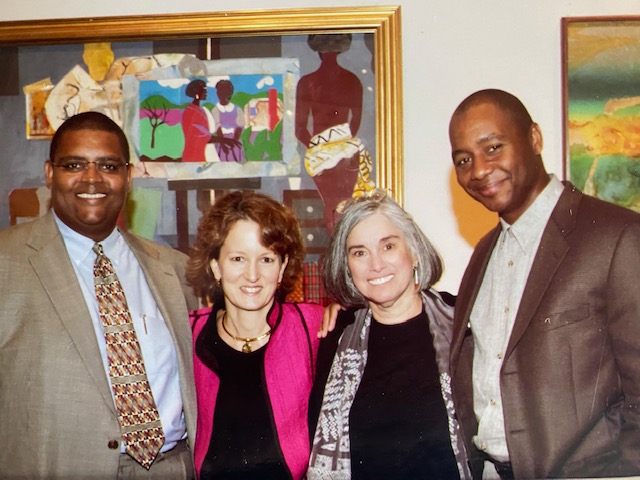
Sometimes, instead of waiting for an invitation, overlooked communities will come knocking at your door. If so, is your museum ready to be fearless, seize the moment, collaborate, share narratives, and maybe even have some fun?
One such case happened at the National Gallery of Art (NGA) some twenty years ago, before our sector had fully embraced diversity, equity, accessibility, and inclusion. Now that the ambition to center and celebrate marginalized communities is more widespread, I wanted to write this post to share some of the lessons staff learned in the process, as inspiration to those doing the work now.
1. Trust your intuition, be fearless, and seize the moment.
“Look out the window, you can still see the thick smoke,” said Sheila Rohan of the Romare Bearden Foundation in New York City. NGA curator Ruth Fine and I peered out the window behind her desk. In the weeks following 9/11, darkness hovered over Manhattan, but at that moment sunlight pierced the ash-filled clouds. We smiled and looked at each other, knowingly.
A few years earlier, Fine had received a visit in Washington, DC, from the widow of artist Romare Bearden, Nanette Rohan Bearden, and her nephew, Tallal I. ELBoushi, to discuss how to care for Bearden’s art. That meeting set Fine on a path of discovery, leading to what would become the NGA’s first monographic exhibition of work by an African American artist and the most comprehensive show of Bearden’s work to date.

In addition to an artist, Bearden (1911-1988) was also a writer and a supporter of the civil rights movement and young artists of color. His collages, paintings, drawings, watercolors, prints, sculptures, quilts, and murals—all of which were to be represented in the exhibition—exemplified the art of creative reinvention, or as he once called it, “[an attempt] to redefine the image of man in terms of the [Black] experience.”
Armed with promises of loans and funding, and the support of the Bearden family and Foundation, Fine was ready to move on with the show. As a native Washingtonian and the NGA’s Chief of Press and Public Information, I knew intuitively that the exhibition would be a long overdue move for the museum in terms of furthering its mission as the nation’s gallery and celebrating an underserved community in its own backyard. Following a coffee break, I seized the moment and asked our director Earl “Rusty” A. Powell III what he thought about Romare Bearden’s art. His characteristically succinct response was, “Pretty good artist.”
Those conversations sparked a chain of events that fast-tracked the NGA’s approval process. Ultimately, The Art of Romare Bearden was scheduled for September 14, 2003, through January 4, 2004, followed by a national tour including stops at the San Francisco Museum of Modern Art, Dallas Museum of Art, Whitney Museum of American Art, and High Museum of Art.
2. Expand your network, collaborate, and share the narrative.
To my mind, showcasing Bearden’s art was an opportunity to jumpstart new conversations at the NGA. Not only had the museum never dedicated a show to an African American artist’s career at that point, but its permanent collection contained significant gaps in the narrative of American art history, including the contributions and stories of African American artists.
As we set out to maximize the impact of the event, Fine shared the news about the exhibition’s approval with the Bearden Foundation, as well as with African American art collectors and scholars, who would contribute to the success of the exhibition. Meanwhile, I proposed a citywide celebration of African American culture to Vicki Isley, Head of Marketing for Destination DC, the city’s official tourism and convention organization, and Kathryn Smith, head of Cultural Tourism DC.
Tourism had declined since 9/11, and Isley was working to attract Black tourists to DC in particular. Smith recalled that the nearby Textile Museum was also planning an exhibition of African American artists, called African-American Quilts from the Robert and Helen Cargo Foundation and suggested them as a partner.
Isley, Smith, Fine, and I concurred and we decided to invite cultural and hospitality colleagues from across metropolitan DC to coffee at the NGA, where we proposed the collaborative citywide celebration.
As it turned out, welcoming these partners would significantly expand the scope and significance of the event. For instance, Smith decided it would be the perfect time for Cultural Tourism DC to unveil the Shaw Heritage Trail it had been designing in DC’s neighborhood named for Colonel Robert Gould Shaw, who commanded the Fifty-Fourth Massachusetts, one of the first Black volunteer infantry regiments to fight in the Civil War. The Shaw neighborhood—where I had moved in 2000 partly for its proximity to the NGA—is the home of Howard University, a historically Black research university, and U Street, historically referred to as DC’s Black Broadway. To cap it off, we realized that 2003, the year of the exhibition, would also be the fortieth anniversary of the 1963 March on Washington when Martin Luther King Jr. gave his memorable “I Have a Dream” speech.
Enthusiasm was contagious as we brainstormed what to call the event. Jennifer Cover Payne, President of the Cultural Alliance of Greater Washington offered the winner: Blues and Dreams: Celebrating the African American Experience in Washington, DC.
With the help of Destination DC, Cultural Tourism DC, and the Cultural Alliance of Greater Washington, word spread fast about the event. Within weeks, ninety-five cultural programs, twenty-five hotel packages, and seventeen themed restaurant experiences across the Washington region had officially joined the celebration. Blues and Dreams would also be promoted free of charge in several publications, including a brochure and map distributed to thousands of Metrorail and Metrobus riders and Museums Washington, a publication by The Art Knowledge Corporation targeting museumgoers.

3. Keep an open mind, be spontaneous, and have fun.
The range of programming that emerged from the event was beyond what we could have imagined. Culinary offerings included “Red, White, and Blues” cupcakes at CakeLove bakery, a “Blues & Dreams Mainstreet” menu at The Ritz-Carlton, “Blues & Drinks” at McCormick & Schmick’s, and a “Blue Note Martini” at Bar Rouge. Dance and music programs included the premiere performance of “Come Sunday: Duke Ellington’s Sacred Music with Dance,” choreographed by the legendary DC-born musician’s granddaughter Mercedes Ellington, and concerts at The John F. Kennedy Center for the Performing Arts by Jazz at Lincoln Center Orchestra under the direction of Wynton Marsalis, himself a Bearden collector who lent works to the show.
The Black Fashion Museum celebrated the pioneering spirit of Sojourner Truth, while the Capital Children’s Museum offered programs for children to “step into” Bearden’s newly published book, Li’l Dan the Drummer Boy: A Civil War Story. A collage mural made by DC schoolchildren inspired by Bearden’s art went on display in the museum’s galleries, while photographer Frank Stewart’s portrait of Bearden went up at the Martin Luther King Jr. Memorial Library in downtown DC.
During the opening week of the exhibition, some two hundred representatives of the Bearden family and Foundation, the NGA, and the citywide Blues and Dreams celebration—including the renowned Black-owned restaurant Ben’s Chili Bowl—showed up with only twelve hours’ notice at sunrise on the front plaza of NGA’s East Building under the exhibition banner. By the time we went live on national television, there was a party going on—cooking, eating, cheering, and dancing to live jazz—with hometown celebrity and national weather forecaster Tony Perkins on ABC-TV’s Good Morning America.

NGA publicist Sarah Holley, who secured the network television coverage, worked tirelessly to distribute flyers about the show and related programs to dozens of Black church congregations. For one of these programs, on a typical Sunday morning, an atypical and diverse stream of visitors to the East Building was greeted by the sounds and aromas of the Restaurant Associates’ Weekend Jazz Brunch, featuring local musicians and culinary creations inspired by What Mrs. Fisher Knows About Old Southern Cooking (Applewood Books, 1995). First published in 1881, it was believed to be the first cookbook by an African American, and maybe the only one by a former enslaved person.

After viewing the show, visitors enjoyed family programs, lectures, concerts, and films, all free of charge. They could purchase a copy of Romare Bearden Revealed, the Branford Marsalis Quartet’s CD produced in time for the exhibition, or the NGA’s videocassette about Bearden’s art narrated by Morgan Freeman with readings by Danny Glover, among many items in the Gallery Shops.
Press coverage and cross promotion between Blues and Dreams stakeholders was in high gear. For example, Branford Marsalis’ friend, actor and producer George Clooney, featured a fictionalized version of the opening celebration of the Bearden exhibition across the first two episodes of K Street, his HBO series about Washington lobbyists starring political commentators James Carville and Mary Matalin. DC-based Blues and Dreams media sponsor Black Entertainment Television (BET) produced two related half-hour specials, one about the exhibition and one about Blues & Dreams.
4. Don’t stop: Keep the relationships and conversations going.
As Smith later wrote for Global Urban Development Magazine, “It was the first time that African American history and culture in Washington, a majority black city since 1957, had been the focus of a major tourism promotion of any kind. And it was the first time a major, federally supported museum on the Mall had partnered so fully with cultural attractions across the city.”
NGA staff continued to build on relationships that developed during this period. For example, it was the start of our popular public conversations with African American artists, historians, and collectors, which have since grown in frequency. Moreover, it was the beginning of a slow but steady drumbeat toward a new era, set in motion more than twenty years ago by the gutsy gallery visit of the widow and nephew of Romare Bearden, who finally had the national spotlight he deserved for his legacy to flourish in the twenty-first century.









Debra Ziska makes very relevant observations in her article. The key is to keep the conversations going with effective programs and initiatives and keep track of measurable metrics. Ai will change the future if content curation in incredible and unimaginable ways. Chance favors a prepared museum!
George, Thank you so much for adding to the story to make it even more relevant. I could write another story about how the conversation did continue, just not as robustly as Ruth Fine and I and others had hoped. But at least the conversation got started. Curious about AI, we should talk more about that. And love the motto: “Chance favors a prepared museum!” I would add: “As long as the museum is willing to take a chance.”
The Alliance Blog is an excellent source when I am looking for examples or models of how museums are doing things or potential presenters and panelists, while a lecturer in the Museum Studies and Cultural Heritage Management programs at Johns Hopkins University or now in my role as chair of ICOM’s International Committee for Marketing and Public Relations. I am glad to also be able to occasionally share examples of my observations and innovative work that is relevant today to my colleagues.
Deborah Ziska gives a terrific sense of the energy and community spirit that was generated by the Bearden city-wide festival. It grew as the days passed, and transformed many visitors’ understanding of the possibilities of cultural activities. Twenty-years later I still get comments from people who came to see that show and participate in other events, about how much they learned and enjoyed through their participation.
It all started with you, Ruth. You had the whole enchilada, the wonderful Bearden family and Foundation, the lenders, the art historians, all raring and ready to go, and all I had to do was light the spark that spread like wildfire across our beloved nation’s capital city with its incomparable African American citizenry and legacy. Washington, DC, the city of Blues and Dreams.
I remember this exhibition well and it’s fun to recall the innovative citywide festivities and partnerships it generated. The steps you mention, Deborah, are good reminders of the energy, creativity, and collaboration that is needed to make it all happen.
It all started with you, Ruth. You had the whole enchilada, the wonderful Bearden family and Foundation, the lenders, the art historians, all raring and ready to go, and all I had to do was light the spark that spread like wildfire across our beloved nation’s capital city with its incomparable African American citizenry and legacy. Washington, DC, the city of Blues and Dreams.
Thank you, Deborah, for recounting this instructive example of how to tackle the critically important work of acknowledging and actively inviting one’s local community to engage. It brings to my mind the critical questions: “What is our purpose?”, “Who is our community?”, and “What is our responsibility to that community?”
As I read this, though, what really caught my attention is that this was done in the early 2000s, nearly 50 years after Washington DC became a majority Black city! And yet it seems that this type of community engagement was ahead of the curve among major museums. It’s all a good reminder of how propelled by propensity nearly all institutions are and how incredibly difficult it is to do something new.
Deborah’s article sparked a response post on the Tronvig blog looking at how hard it is for organizations to change the way they see the world.
Tronvig Blog article:
https://www.tronviggroup.com/museums-and-community/
James Heaton, founder and lead strategist of Tronvig responded to my recent Alliance Blog article, “Seizing the Moment: How Museum Outreach and Programming Can Champion Overlooked Communities” with a profoundly thoughtful article in Tronvig’s Blog today, “Museums and Community: The Struggle to See What’s Right In Front of You.”
He encourages us to reflect on the actions we take or don’t take today and what that will mean tomorrow. Lots to chew on here in a world that needs each of us to make a difference in our own backyard.